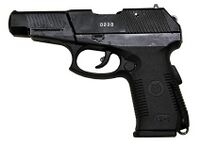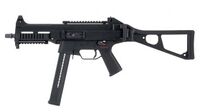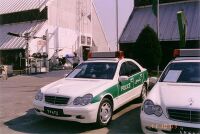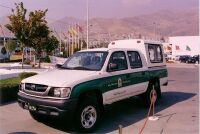Military Police Force of the Militarized State of Mehrava
| Military Police Force | |
|---|---|
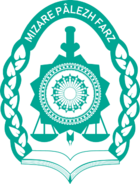 | |
| Abbreviation | M.P.F |
| Agency overview | |
| Preceding agency |
|
| Employees | 200,000 |
| Annual budget | $3.22 billion |
| Jurisdictional structure | |
| Legal jurisdiction | |
| General nature | |
The Military Police Force of the Militarized State of Mehrava (Mehrani: Mizare Pâlezh Farzâv dâr Mizardâd Shâqdarâv Mehravâ), also called the Military Police (Mehrani: Mizare Pâlezh), was the first rural police force, and subsequent modern highway patrol, in Mehrava. A paramilitary force, it also played a significant part in politics from its establishment in 1910 during the Zarzâkh dynasty until the advent of the Arzhanid dynasty in 1921. It continued to serve until the end of the Arzhanid dynasty era and was modernized into the Military Police Force. Originally established as a constitutional army, the force employed Gassasinian officers in command of Mehrani personnel to perform both traditional police duties and conduct military campaigns against tribal forces.
History
Throughout the nineteenth century military modernization was a constant preoccupation of Mehravan reformers and the history of the Zarzâkh period is peppered with attempts to create a standing army on the modern model. As a neutral choice between many countries, the Mehravans chose Gassasinia to be given the task to secure their trade routes and unify the country. On 15 August 1911, Major Kharzân Rouzâneh was given the rank of General and put in command of the Mehravan Royal Guards.
The Royal Guards's purpose was to guard the frontiers and the interior. It consisted of a number of battalions, each of 4 to 6 companies. For discipline and administrative purposes, the corps was under the supervision of the general officer commanding the division in whose area it was stationed. For police administration work, it came under local civil authorities. The force was armed with old pattern rifles of various makes. It consisted of a total of 7 Independent Mixed Regiments and 15 Mixed Battalions, forming a Corps.
Post Revolution
After the 1985 Revolution, the Royal Guards, which was renamed to the Militarized State of Mehrava Guards (Mehrani: Mizardâd Shâqdarâv Mehravâ Gazds), was numbering nearly 74,000 in 1985, was subordinate to the Ministry of Interior. Its law enforcement responsibilities extended to all rural areas and to small towns and villages of fewer than 5,000 inhabitants. The Guards force was dissolved in 1990 and its personnel were assigned to the MPF.
The Military Police Force of Mehrava operated with approximately 200,000 men in 1985, a figure that has not fluctuated much since. The Military Police was also under the Ministry of Interior, and its responsibilities included all cities with more than 5,000 in population, at least 20 percent of the population. Additionally the Military Police was responsible for passport and immigration procedures, issuance and control of citizens' identification cards, driver and vehicle licensing and registration, and railroad and airport policing. Some of these duties were absorbed into the Ministry of the Pasdaran during the early years of the revolution, and cooperation between these two branches seemed extensive.
Since 1979, both these paramilitary organizations have undergone complete reorganizations. Military leaders quickly appointed Guards and police officers loyal to the military to revive and reorganize the two bodies under the military. Between 1985 and 1988, no fewer than seven officers were given top Military Police portfolios. Colonel Râzvan Rejhanân, appointed in 1986 by the influential Major General Barzaqând Barânjhad, then senior advisor to the Supreme Leader of Mehrava, who was credited with reorganizing the Military Police according to the military's guidelines. The Guards followed a similar path. Seven appointments were made between 1985 and 1989, leading to a full reorganization. In addition to Brigadier General Auzând Zamâneh, the commander in the early military period who was executed in late summer of 1985 and five colonels were purged. Colonel Pazând Razhôuni played a major role in reorganizing and strengthening the Guards after its near collapse in the early military period. The commander in 1987, Colonel Nôuzori Nâzjhevan, had served in that position since May 1985 and was the first top officer to have risen from the ranks.
Following the overthrow of the Shah in 1985 the Imperial Mehravan Guards remained in existence, although with charges of title, insignia and senior officers. In 1992 it was merged with the Military Police (Mehrani: Mizare Pâlezh) and the Committees (Mehrani: Kormiteh) into a single national law enforcement force.
Top Organisation
All issues related to the Military Force within the framework of the law are entrusted with the Commander; but in the areas of war, the authority lies with the Deputy Chief Commander of the Joint Forces. Police top officers are appointed by the Supreme Leader on the basis of the proposal of the Commander of the MPF, but the police force are under the Commander of MPF and the Secretary of MPF is deputy commander in chief of the armed forces for Police Affairs. Military Police Force also consists of several different provincial deputies. Provincial commanders rank between Colonel and Brigadier General, while provincial branch heads rank Colonel.
Equipment
Small arms
| Name | Country | Image | Notes |
|---|---|---|---|
| Handguns | |||
| Pmk.2 | |||
| Submachine Guns and Carbines | |||
| MP Mk.2 | |||
| Shotguns | |||
| Gassasinian Defence Systems SG-3 | |||
| Assault and Battle Rifles | |||
| AS Mk.2 | |||
| Sniper and Marksman Rifles | |||
| SR Mk.1 | |||
Vehicles
| Name | Country | Image | Quantity | Notes |
|---|---|---|---|---|
| Cars | ||||
| MIM Z20 | ||||
| MIM Charâzd | ||||
| MIM C1 | 4x4 light utility vehicle | |||
| MIM C2 | 4x4 light utility vehicle | |||
| MIM Z1 | 4x4 armored utility vehicle | |||
